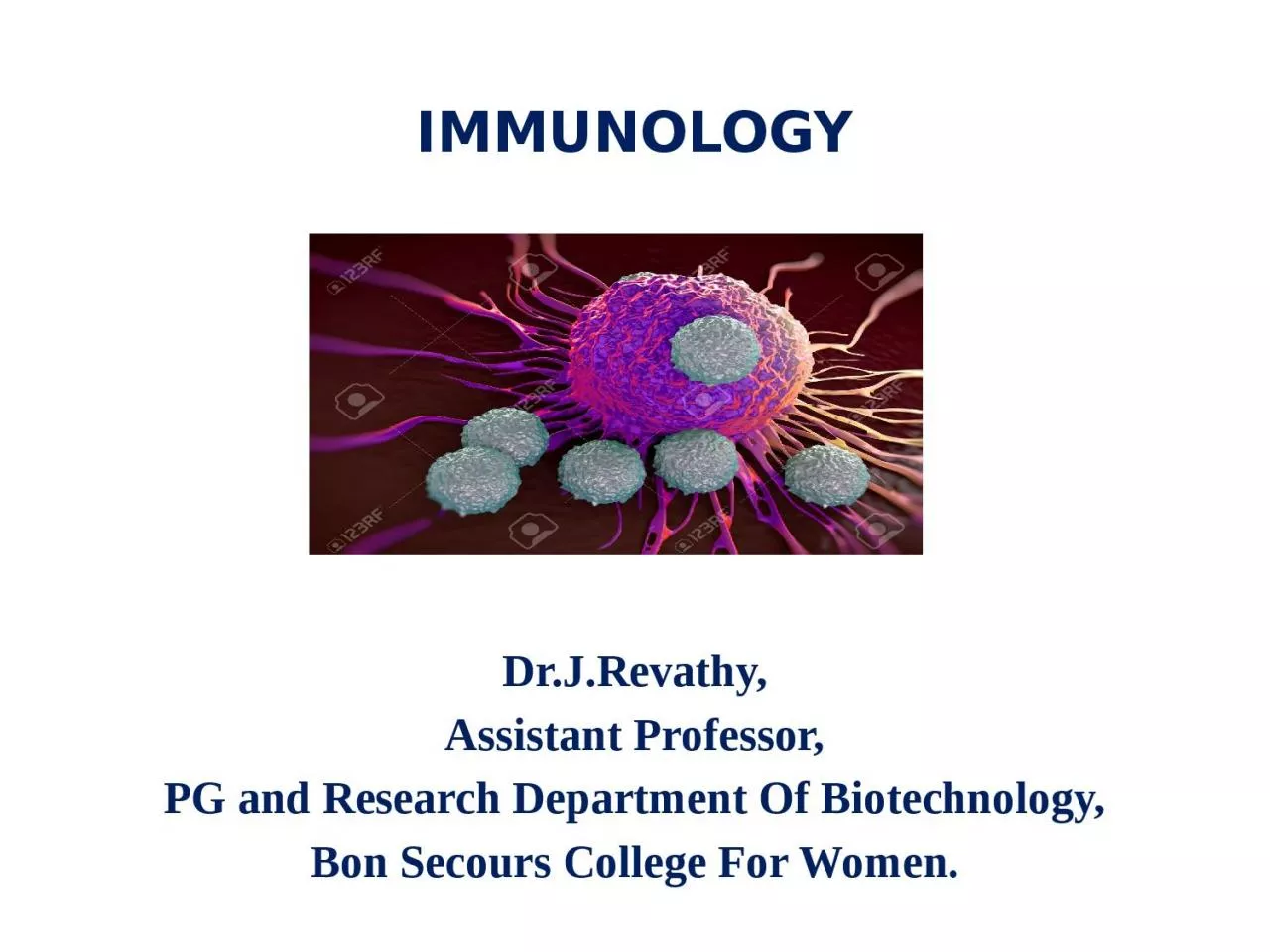

Assistant Professor PG and Research Department Of Biotechnology Bon Secours College For Women IMMUNE SYSTEM Immune system from the Latin word immunis meaning free or untouched ID: 935395
Download Presentation The PPT/PDF document "IMMUNOLOGY Dr.J.Revathy," is the property of its rightful owner. Permission is granted to download and print the materials on this web site for personal, non-commercial use only, and to display it on your personal computer provided you do not modify the materials and that you retain all copyright notices contained in the materials. By downloading content from our website, you accept the terms of this agreement.
Slide1
IMMUNOLOGYDr.J.Revathy,Assistant Professor,PG and Research Department Of Biotechnology,Bon Secours College For Women.
Slide2IMMUNE SYSTEM
Immune system
(from the Latin word immunis, meaning “free” or “untouched”)
It protects the body like a guardian from harmful influences from the environment and is essential for survival.
It is made up of different organs, cells and proteins and aside from the nervous system, it is the most complex system that the human body has
Slide3Slide4Organs of immune systemLYMPHOID ORGANSClassification-Based on functional development of lymphocytic cells, the lymphoid organs can be classified into three groups:Lymphoid organs involved in genesis of lymphocytesYolk sac of embryoFoetal liverBone marrow
Slide52. Central/Primary lymphoid organs(involved in immunological differentiation of various lymphocytes) Thymus Bursa of fabricus Bone marrow3. Peripheral/Secondary lymphoid organs (functionally matured lymphocytes concentrate and respond to antigenic stimuli) Lymph nodes
Spleen
Gut and Mucosa associated lymphoid tissue
Slide6Stem cells
Lymphoid
organs
(Migration)
Primary Lymphoid
organs
Differentiation &
Maturation of Stem cells
Slide7Yolk sac of embryo give rise to stem cell of haemopoietic tissue, lymphoid stem cell & colonize in foetal liver and the to bone marrow.Bone marrow – chief source of stem cell in adult life.
Lymphopoiesis & genesis of other haemopoietic cells- occurs in
red bone marrow
found in foetal bones & postnatal life.
In adults found in flat bones, bodies of vertebrates, short bones & ends of long bones.
Remaining marrow is replaced by fat cells known
as yellow marrow.
Slide8Slide9Slide10Slide11ThymusLymphoid organ where differentiation of T-lymphocyte occursIt is a lymphoepithelial bilobed structure located behind the upper part of sternum.It is capsulated and septateSepta are called trabeculae arises from capsule which divides the gland into lobules.Cells in the globules are arranged into outer cortex and inner medulla.
Slide12Cortex- composed of epithelial cells & lymphocytesEpithelial cells are larger than lymphocytes and forms three dimensional network in meshes of which lymphocyte found.Precursors of lymphocytes (SC) from yolk sac, foetal liver and bone marrow reaches thymus, matures in cortex, acquires surface characteristics of T-lymphocyte and then migrates to medulla.
Slide13Medulla- lymphocyte matures enters into blood as matured T-lymphocyte to the peripheral lymphoid organs.Medulla also contains- reticular epithelial cells, interdigitating cells & some peculiar strucures called Hassall’s corpuscles which are small masses of epithelial cells with central degenerating epithelial cells.
Slide14Functions of ThymusCentre for development of immune system
Major Site for lymphocyte proliferation and production of
T-lymphocytes
T-lymphocyte acquire surface markers and become immunologically competent
Slide15Slide16Bursa of Fabricus
Central lymphoid organ in birds where differentiation of B-lymphocyte occurs.
It was first described by
fabricus
in 1621 and it is absent in mammals.
In mammals the differentiation and maturation takes place in bone marrow.
The structure is similar to thymus and formed with many lobes called lymphoid follicles.
Slide17Functions Responsible for development of immunocompetent B cells.
B Cells acquire the surface antigens and then migrate to secondary lymphoid organs where they become plasma cells producing antibodies.
Each follicle is divided into outer cortex and inner medulla which are composed of lymphocytes, macrophages and B cells.
Precursors of B cells (SC) from yolk sac, foetal liver reach bursa and mature into immunocompetent bursal lymphocytes or B cells which enter into blood and migrate to secondary/ peripheral organs.
Slide18Slide19Slide20Bone marrow
In mammals B cells differentiate and become mature in
bone marrow, a soft tissues present in bone cavities.
In addition to SC, they are involved in the production of various blood cells.
Bone marrow contains-
erythrocytes, platelets, granulocytes, monocytes and lymphocytes
with their precursors-
megakaryotes, reticulum cells, macrophages and plasma cells.
Slide21FUNCTIONS OF Bone marrow
Production of different blood cells
erythrocytes,
leukocytes, platelets from HSC.
B cells differentiate, mature and acquire immune response.
Functions both as central & peripheral lymphoid organ.
During secondary response activated memory B cells migrate to bone marrow and mature to plasma cells that produce antibody secreting cells.